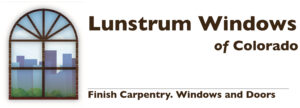Doors
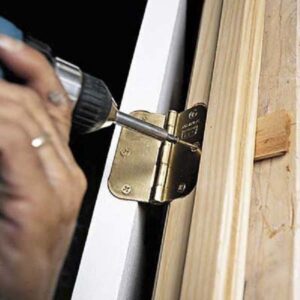
Door Installation
Door Installation
When you require door installation services you’ll need to work with a reputable contractor and door company to make sure that the installation is done properly. A well-installed door will provide increased energy efficiency, will be easy to open and close and will look straight and precise for aesthetic purposes. Some of the factors to consider when you’re choosing a new door to be installed include deciding on a left-handed or right-handed door, the door swing, the material and the look of the door itself.
Left-Handed Versus Right-Handed Doors
Choosing between a right-handed or a left-handed door is often the easiest decision you’ll have to make when choosing the correct door. Sometimes it won’t matter which one you choose while at other times it will make an impact on the door’s usefulness. It’s likely that you will simply match up the door type to the existing door that is already there. If you need any help with your decision, you can contact us for a free consultation and we’ll let you know whether there are any special considerations that you should keep in mind when making your choice.
Door Swing
In most cases you’ll end up choosing a door that swings open to the inside of the home and in only a few select cases will you choose a door that swings outwards. Firefighters prefer to see inward swinging doors since they can easily break them down and make their way into the home more easily in the case of an emergency.
Material Choices
You’ll have plenty of choice when it comes to the material for your door including wood, steel and fiberglass. For many people, there is nothing that can rival wooden doors since they offer a refined beauty that can’t be found in any other material. When you need a new door installation in the Sacaton area, you’ll find that we have a wide variety of wooden doors to choose from.
Steel doors provide a high insulating value and offer more security than wooden doors. These are the perfect type for people that want a low-maintenance door that doesn’t tend to warp or crack easily.
Fiberglass doors are also low maintenance and are extremely scratch resistant. They offer much the same benefits as steel doors but have quite a different look to them. In many cases the choice between steel and fiberglass will come down to personal preference.
The ultimate overall quality of your door will not only depend on the type of material and style you choose but the installation itself. Hanging a door properly is a technical science that requires experienced and highly-trained personnel. This is not a job for a handyman since the precision involved is extreme when compared to other type of renovation work. Only use a company that uses professional installers and guarantees the work so that you can get the best value for your money from your door.

The art of windows by Steve Lunstrum
The art of windows by Steve Lunstrum
- Windows are an important part of our homes and buildings… we like windows!
- They let in light
- Windows make us feel more like we are outside
- They let us see what is going on just outside our doors
- They provide ventilation and cooling
- So what are the problems? On the flip side…
- Light damages interior and windows let in heat along with light
- Sometimes the outside air is too hot or too cold and so needs to stay outside.
- They let others see what we are doing too
- They leak air even when closed and we don’t want ventilation
- What are the main issues that people have with their windows?Heat gain (The big one in AZ)
- Heat loss (more of a problem than you might think)
- Damage to furniture, floors and drapes from light degradation (esp. ultraviolet)
- Leaks and moisture
- Operation of windows
- Appearance
- Comfort
Can new windows solve these problems and make your life better?
Well, maybe it’s a stretch to say it will make your life better, but new windows can and will address the problems you face with the windows in your home!
You may have noticed how hot it can be in front of your windows. Light (visible) is not the only thing that comes in through the window. There are light waves in the ultraviolet range (higher frequency) and the infrared range (lower frequency). Heat energy is transferred directly to the inside of your home especially by the light/heat waves in the lower range frequencies.
This can be a problem if, as here in Colorado, we have an overabundance of sunlight. Many homeowners have taken steps to counteract this problem with various results.
Applied film works well, but did you ever feel the surface of the glass when the sun hits a tinted window? The tint does some reflecting of the heat but much of the energy is absorbed by the glass itself. And then where does much of it go? That’s right, inside your home. Cool air hits the inside surface and rises as it is heated, actually drawing more cool air into the cycle that is created by the temperature differential. You effectively have heat radiators at all your windows hit by the sun.
Another good way to cut down the heat gain is by installing sun screens. They absorb and reflect up to 90% of the solar radiation. Of course, you no longer really have a window. You can’t really see out any more. Why not just board up your windows? Many say that they can remove the screens during the cooler months, but face it, they never do. But, if you like the idea of living in a cave, it’s a great solution.
Others use paper, cardboard or even reflective aluminum foil to stop the blazing sun. Awnings and window shades, even expensive retractable motorized shades are used to good effect in our area. But, is there another solution?
Can high-performance window products solve many of the issues without compromising the positive purposes of windows?
Consider some relatively new, yet well tested benefits of modern windows.
Why is this considered a problem? After all, most of us get our highest energy bills are in the summer. But, there is a lot of energy lost thru heating losses for the rest of the year. It can get quite cold here sometimes at night. Many of the features of high-performance glass and window frame that deal with heat gain also work to lessen heat loss. (How convenient!)
Here is how window heat loss affects you.
Your heating system produces heat (This costs you money!)
The windows in your home transfer this heat to the outdoors.
Your heating system produces more heat so you can be comfortable.
Single-glazed windows have an R-factor of about 1.0. With some of the “dual glazed” windows used in many homes the R-factor is not that much better. A typical aluminum window with ½” dual glazing (not Low-E) is rated about R-1.33. R-factor is the number that shows the resistance to heat flow. (See discussion of terms) Compare this to an average insulated exterior wall that is rated at an R-16. So, if you have a bedroom wall about 12 foot long and 8 foot high and just one 4’ x 4” window of about 16 square foot you would lose more heat thru the window than thru all the surrounding wall area. In fact probably over twice as much! The same thing applies to heat gain of course. (But that is considered on another page)
So with single-glazed or dual glazed aluminum windows you lose heat… and money!
Modern high performance windows and glazing can reduce heat loss by as much as 80%. That is a substantial amount of the heat you lose. Is it worth the investment? That is what you will need to decide. But with the other benefits of new windows, including increased comfort, less interior damage, better operation, and added home value… many homeowner have decided that new windows are well worth the money.
[/fusion_toggle][fusion_toggle title=”Fading and other damage to furniture, floors and drapes” open=”no”]
Most people know that ultraviolet light damages furniture, floor coverings, drapes, and even us to some extent. It even damages us…our skin, hair, eyes, and even our genes! What they don’t know is that visible light causes about 1/3 of the damage done. So, eliminating UV does not eliminate all damage. It does though, lessen it. For example with many films, such as Low-E films on dual-glazed windows, aftermarket tints, and laminated glass (which has a Mylar film between two layers of regular glass), the UV light rays are reduced by up to 98%. So, for example, that means that if you allowed the sun to hit your couch directly (without UV protection) for 10 years it would be damaged to a certain degree. If you had UV protection, the same damage would take 30 years. (You might need or want a new couch by then anyway)
The positive point about UV protection is that it is very cost effective. Low-E coatings, for instance, pay for themselves by saving energy. They do so very rapidly and are now so inexpensive that most manufacturers have Low-E as standard glazing on their products. Tints have light and heat inhibiting properties and are worth it for the comfort they produce. And laminated glass is so strong that it is used to “bomb-proof” public buildings.
So, the UV inhibiting factor is often just a nice bonus.
[/fusion_toggle][fusion_toggle title=”Window leaks and moisture problems” open=”no”]
How do windows leak?
Sometimes it is a design issue. Windows are not designed to be roofs. (Unless they are skylights) They need to be the right size and type; otherwise there can be problems with inappropriate application.
Sometimes it is an installation issue. If the window is not installed correctly and sealed properly, it can leak. That is why you would choose an experienced and knowledgeable contractor to install your new windows. Or, if you are installing them yourself, make sure you understand the principles of window installation and building envelope integrity. Most manufacturers supply recommended installation techniques and specifications.
Sometimes it is a quality and workmanship issue. You often do…get what you pay for. So, choose windows like you would any product that should last 10-30 yrs…very carefully. Be prepared to spend a little extra to get something that will work, will last and will make your home a better place to live.
But, even if it is well made, properly installed and the right type of window…a window can deteriorate and leak. Wood windows frames will rot, sealed units fail and fog up, and even aluminum frames can be affected by the ravages of time and the elements. Here is where a great warrantee will come in handy.
Leaks can also appear to be from the windows, but are actually some other building component. A common culprit is the roof. Here is how it works… the roof leaks into the wall system, goes down the wall, encounters the well-sealed exterior frame of the window and, with nowhere else to go… enters the interior of your home.
Remember this:
- A professional examination of any leaks connected to windows is vital to determine what would be the best way to fix the problem. Don’t settle for less for your home. Water damage is not limited to what you can see, like stains from water intrusion on drywall and other interior finished surfaces. It can stay hidden and result in rotten wood framing and worse. Mold and mildew are not only very unsightly, but they can be unhealthy and even dangerous in the closed environment of a dwelling.
Window operation
Or….When windows attack!
How frustrating it can be when we get old. Windows get old too. And when they do, just like us, they don’t work so well. Wood windows swell and crack. Aluminum windows get corroded and the moving parts stick and sometimes won’t move at all. Hardware breaks and often the parts are no longer available to repair them. We often come across windows that refuse to even budge because they are painted shut. It’s hard to get ventilation when you need it, and more importantly, this can even be a safety issue. For instance if you have a house and you can‘t open your windows, you could be in real danger.
Modern windows, using superior materials and engineering, often operate a lot better than their older counterparts. Industry standards have made improvements mandatory. The leaders in the industry, companies like Milgard, Pella, and Anderson, have helped raise the standard too. Constant research and development brings both new products and improvements to existing ones. You, the customer, benefits.
So, take a look at the sample windows available. Try them out, play with them a little. See if you don’t think that they just work better.
Appearance
Closely related to operation would be appearance. Some people never open their windows, so the operation doesn’t matter much to them. But they do want their homes to look good. They want them to look new (or sometimes they want them to look old). Windows can and should dress up a home, make it look attractive and inviting. Exterior and interior colors are becoming more important to many window buyers. Other options including tinted glass, grids and muttons, and leaded glass. These all can add interest and focus to a home’s design. Many customers add obscure glass to the mix. Obscure glass can be as simple as frosted glass to much more sophisticated types like delta frost and rain glass. Glass block can add an even more interesting appeal to the window systems of a home. The combination of window elements and options is nearly endless.
[/fusion_toggle][fusion_toggle title=”Comfort” open=”no”]
Do you want to be comfortable in your home? Of course, we all want to go home and just relax. But, if you have to worry about cold spots and drafts in the winter and hot areas near the windows in the summer, you are not going to be very comfortable. Why are windows sometimes the worst offenders when it comes to these things? Just look back at the information under “Heat loss”. To quote “A typical aluminum window with ½” dual glazing (not Low-E) is rated about R-1.33. … Compare this to an average insulated exterior wall that is rated at an R-16. So, if you have a bedroom wall about 12 foot long and 8 foot high and just one 4’ x 4” window of about 16 square foot you would lose more heat thru the window than thru all the surrounding wall area.” But, total heat or cold loss is not the only factor. Because they are colder (or hotter) than other exterior surfaces such as walls, they tend to introduce air currents inside your home. Warm air rises, most people think. Actually cold air drops or falls toward the ground because it is heavier than warm air. It then starts a circuit where warm air is cooled, drops and is replaced by more warm air, and so on and on. The windows kind of act like a heat radiator in the summer and an air cooling system in the winter.
Get the point? Well, do something about it! Get rid of leaky, drafty, and inefficient single paned or aluminum windows. Replace them with new, energy efficient windows and enjoy the benefits.
The three major types of heat flow that occur through windows are:
- Conduction (heat conducts well through metal and glass, not so well through air space, vinyl, or wood)
- Convection (airflow both intentional (ventilation) and unintentional (infiltration)
- Radiation (Solar radiation brings heat into your home, but radiant heat also leaves your home in the winter.)
Of these three the first two are the most critical in the cooler months. In the summer the third becomes the biggest factor in most cases. How can new windows benefit you in these areas?
Science can measure the heat loss through windows and translate these into data that we can use. Windows have to have energy ratings. They must tell us four things: (for the whole window assembly, not just the glass)
- What is the U-factor?
U-factor is the opposite of R-factor. U-factor measures heat flow. R-factor measures resistance to heat flow. In other words you want a HIGH R-factor (for example insulation batts are R-11 to R-30 or more). You want a LOW U-factor. A good U-factor for windows is .50 or less. (.30 is even better)
- What is the solar heat gain coefficient?
Solar heat gain through single paned glass is almost the same as if nothing was there. You are EXPOSED! A SHGC of .50 reduces that solar exposure by half. Obviously you want windows that can reduce it even more than that. A value of 0.35 is good. Some are even better than that.
- What is the Visible light transmittance?
Is this important? Only if you want to see out of your windows. Single glazing reduces visible light by about 10% (hardly noticeable). Dual glazing – 20% (you can tell if you hold them side-by side up to the sky) Low-E glass (in dual-glazed windows) – 30-40%. (Again you will need to have them side-by-side) You will see a difference with tinted windows. Some tints reduce visible light up to 85%. (limo tint)
- What is the Air leakage rating?
You don’t want leaky windows! Newer windows with modern weather-stripping usually have ratings better (less) than 0.37 CFM/sq. ft. (That means the number of cubic feet of air leaking in or out with a specified wind pressure for each square foot of window.)
[/fusion_toggle][/fusion_accordion][/fusion_builder_column][/fusion_builder_row][/fusion_builder_container]
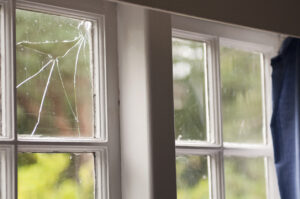
Glass Window Repair
 Glass Window Repair
Glass Window Repair
If you live in the Colorado area and have a chip or a crack in your existing window it may be worth your time and money to consider a glass window repair instead of replacing the entire window itself. In many cases glass can be repaired at a fraction of the cost of replacing an entire window. You may also want to consider repairing your glass windows if you’re concerned about the energy efficiency of your existing ones.
Increase the Energy Efficiency
In some cases your old windows can be saved with simple repairs. If you’re having a problem with drafts we can help you remove and then replace the caulking around your windows and applying weather-stripping to them. In some cases we may also recommend adding storm windows for added efficiency.
Older Windows
You may not have to give up completely on your older windows just yet. If the cost of replacement is not workable according to your budget, we can often provide you with different solutions. In some cases the windows that you currently have add to the architectural detail of your home and replacing them wouldn’t be the best option. If this applies to you, give us a call and we’ll let you know which glass window repair services would be best for you.
Chips and Cracks
If your glass has a chip or a crack it may still be repairable and in most cases we will have to replace the entire piece of glass. There is often no need to buy a brand-new window, however, and your glass replacement costs will be quite low when compared to replacing the whole window. If the crack or chip is very small, we may be able to repair it but we’ll have to see it first before letting you know exactly what your options are.
When Do Old Windows Need to Be Replaced?
We recommend replacing your older windows if there is any chance that they were painted with lead-based paint. This type of paint was originally banned in 1978 and can commonly be found in older homes. Every time you open and shut the window you are creating friction and may be releasing lead dust. Your best option is to replace these windows completely by using a qualified window repair company in Eloy.
In some cases, replacement is your best option when the glass is completely broken, when you are dealing with split or rotting muntins, are experiencing excessive water infiltration or your exterior casing is rotten, cracked or loose. If you have any of these problems, please call us and we’ll come out to take a look at them. We’ll let you know whether repairing the issue is at all possible or whether the windows should be replaced altogether.
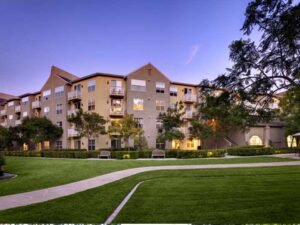
Covington
Covington: This project was our first major new construction project. It was completed in 2002. There were 700 windows and 150 patio doors. All were from our principal supplier, Milgard Manufacturing. This was also our first of several projects for DPR Inc.
Entry and front lawn (Most windows are Milgard’s Styleline vinyl window, Patio doors are Classic series.
Garden view: After 10 years the trees are maturing. The windows are still fine.
There are several cottages that are part of this modern Senior retirement complex. That is not my grandma.
Pool view with arch top windows
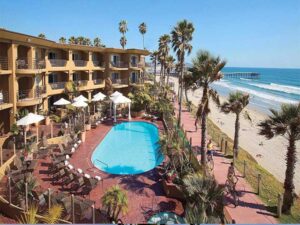
Pacific Terrace
Just north of downtown San Diego is the exclusive Pacific Beach area. Here we installed about 75 sliding patio doors for Bartell’s Pacific Terrace Hotel. The patio doors take full advantage of the beautiful views of the ocean.

Old Globe
Another DPR project we were able to be involved in was the Old Globe Theatre in Balboa Park, San Diego.
We used Jeld-Wen wood windows and French doors. (They used to be called Pozzi, one of several companies bought by Jeld-Wen. It is now one of the largest window companies in the world)
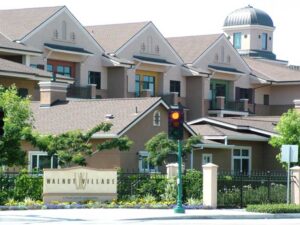
Walnut Village
One of our more recent additions to our portfolio is this project, Walnut Village. It is a Senior residential property located just ½ mile from Disneyland in Anahiem. A unique color scheme marks the main building complex. The windows in the cottages however, (shown in the foreground below) were done in white.

Humphreys
Across the bay from Downtown San Diego is Shelter Island. There is a famous hotel and destination resort called Humphreys by the Bay. We were invited to install new windows and sliding patio doors in most of the hotel rooms for this beautiful property.

Miracle Mile
Here is another project in LA. They called it the Miracle Mile project. Located on Wilshire Blvd. about 1 or 2 miles from Downtown LA, it is luxury apartment complex with some 140 units. There were some 3000 individual windows and 140 French doors.
An architectural feature of this project is the curved glass windows at all four corners of the building. These had to be custom ordered after the openings were framed so that they would fit perfectly. Templates of the base of each opening were sent to the fabrication location. Those units had to be dual glazed. They were a lot of work and expense, but they look great.
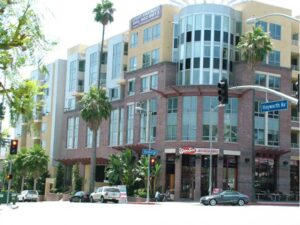
Sunset Lofts
Here are just some of the projects we have successfully completed in the last 20 yrs.
Sunset Lofts: a luxury 150 unit apartment building in Los Angeles on the famous Sunset Blvd. Completed in 2008 this property is a landmark in a prestigious area near downtown LA. With over 850 window and doors it was quite a project. Note the windows that extend from the 2nd to the 3rd and from the 4th to the 5th floors. They measured 6 or 8 ft wide and 16 ft. high and are comprised of 10 separate windows mulled together.
The windows between the floors had spandrel glass (silver-grey coating on the inside) so that the floor framing was not visible. All the glass on this project was 3/16 and ¼” thick for sound absorption. The 10 window combination units weighed in at over 800 lbs. They had to be assembled and glazed on site by our technicians. The corner windows were a challenge to install but they certainly add dimension and a classic look to this fine piece of architecture.
